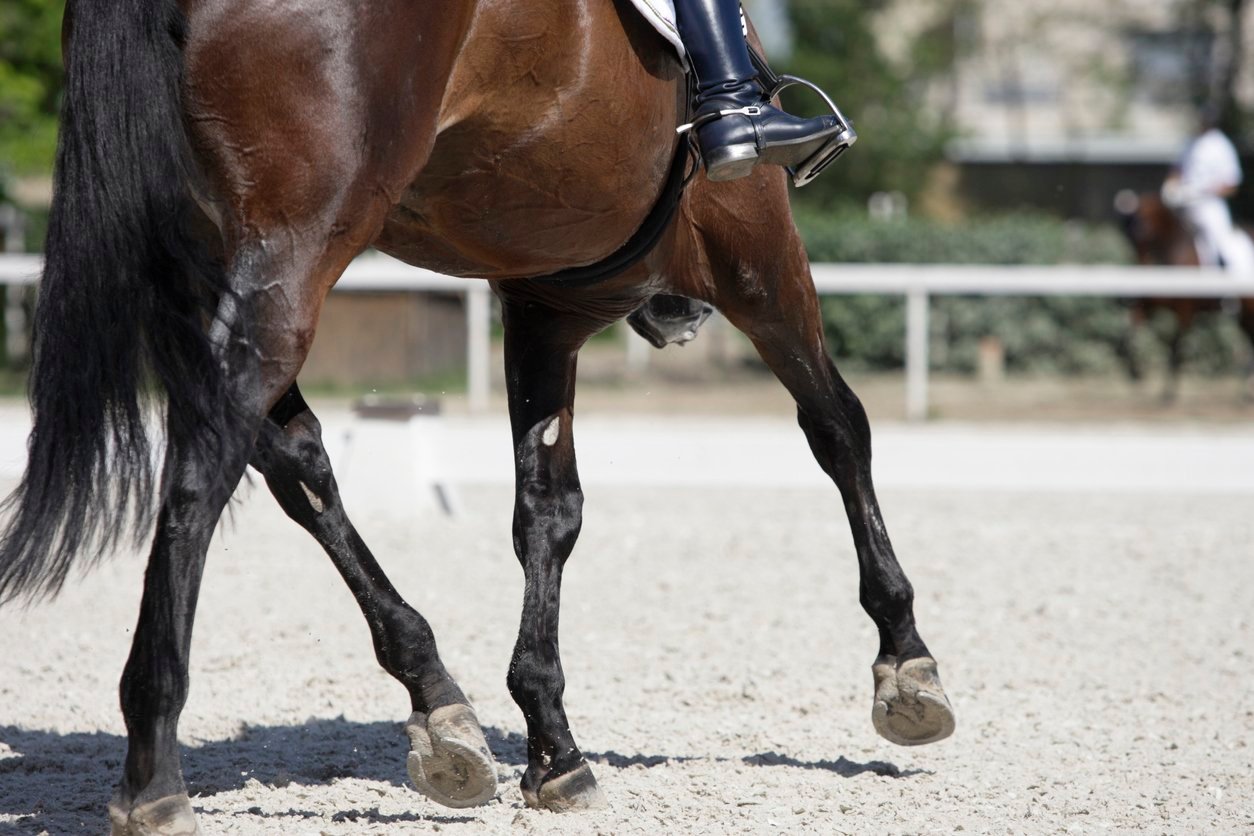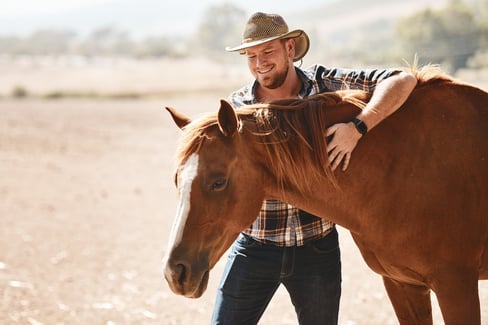Table of Contents
Your horse loves to trot, jump and gallop the days away.
They want to be free to move, especially if you have a sport horse on your hands.
But sometimes, your horse can get stuck—literally.
Locking stifle is a painful, but common horse health condition that can create a lot of problems for your horse’s mobility.
In this post, we’re going to get into everything you need to know about locking stifle, from causes to treatment.
That way you can keep your horse feeling their best and avoid the painful hang-ups that come with locking stifle in horses.
What is a Locking Stifle in Horses?
Intermittent upward fixation of the patella — now that’s a mouthful!
It’s also the technical name for locking stifles in horses.
Like the human knee, horses have a joint that acts like a hinge to help your horse move, rest, and stay upright, called the stifle. This joint is very important for overall horse functioning, as you can likely tell. In fact, horses need this joint to properly lock in place in order to stay standing up while sleeping!
In order to understand what locking stifle horse problems look like, we need to take a moment to go over the basic anatomy of the super important stifle joint first.
The stifle is made up of the following four bones: the femur, patella, fibula, and tibia.
This joint plays a critical role in a horse’s functioning, with many parts working together in coordination to help movement and locking. The patella has three ligaments connecting it to the base’s tibia. At the end of the femur, there is a notch known as the medial trochlear ridge. Ligaments hook around and lock the stifle into place at this location.
Think of the ligaments like an elastic band. They can stretch and flex, allowing the patella to glide upwards and downwards as the horse goes from movement to rest.
When a horse has a locking stifle, its patella is stuck upward, meaning it is unable to move out of the ridge on the end of the femur. If the horse tries to move forward as it typically would, the leg will remain extended.
Sometimes the delay is momentary, and simple backward movement can get the patella to slide back in place. Other times, the patella remains locked and can extend the delay. That is when your horse will face more severe symptoms.
Now that we’ve gotten our introductory anatomy lesson out of the way, you might be wondering how typical locking stifles are.
Locking stifle horse problems are one of the most common ailments affecting a horse’s kneecaps. Thankfully, that means lots of research and information are available to horse owners and veterinarians alike.
Locking Stifle Horse Symptoms & Diagnosis
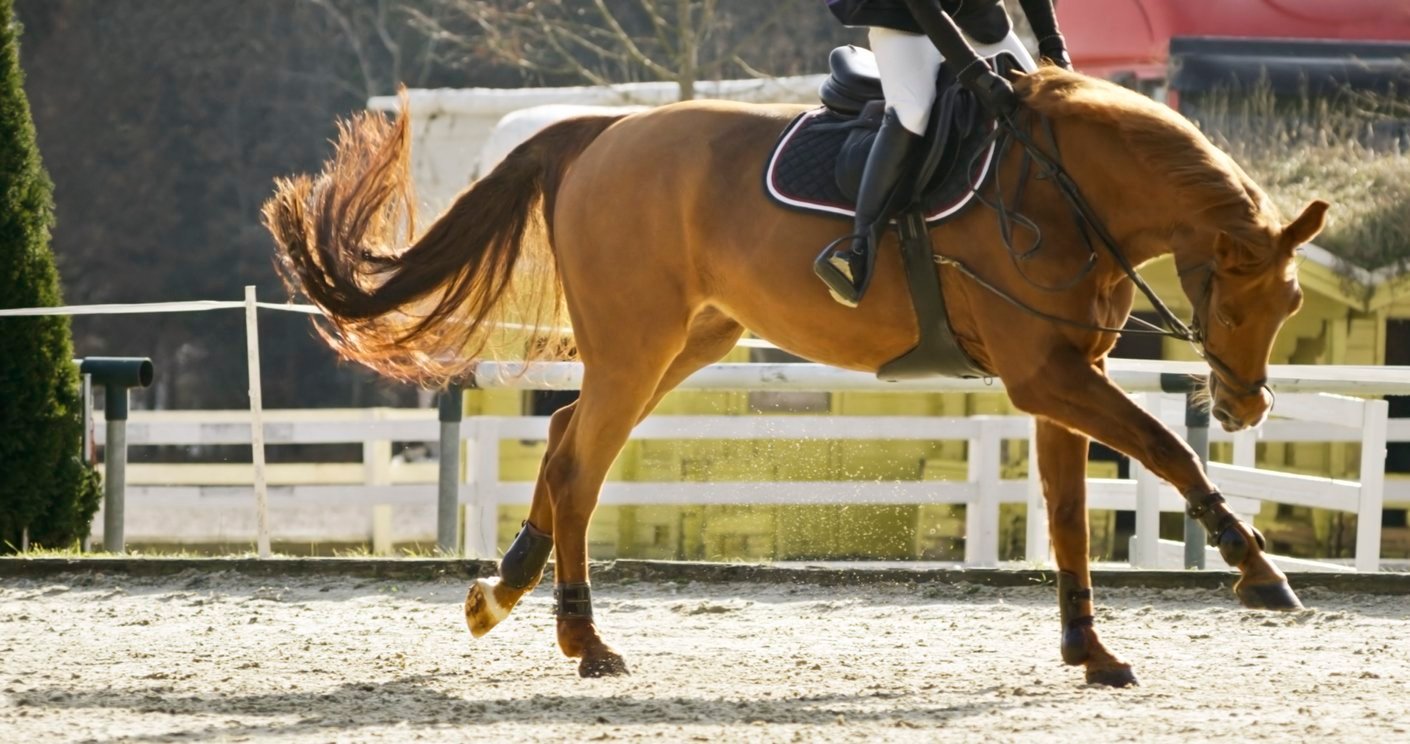
So how do you know when your horse is affected by locking stifle? And what do you do about getting it diagnosed by a vet?
Unlike other horse health conditions, locking stifle horse problems may not be easy to detect.
With other conditions like thrush or suspensory ligament horse injuries having more obvious and consistent symptoms, you can often spot the problem before you even call for the vet.
Even experienced trainers can miss the signs of locking stifle. When your horse appears to behave strangely or is resistant to new training techniques, it could be due to stifle problems.
However, there are some signs and locking stifle horse symptoms to watch for, especially if they appear in combination:
- The horse drags his leg or his hind toes during exercise
- Locking of the back leg, or the back leg remains extended after movement
- The horse stumbles or falls frequently
- Audible popping noise coming from the leg when moving
- Reluctance or resistance to canter
- Swelling around the stifle joint
- Resistance when backing up
- Horse struggles walking up or down hills
- Lameness is more prominent following extended stall rest
- Lack of muscle tone in limbs
To diagnose a locking stifle horse, your veterinarian will begin by checking your horse’s weight and blood pressure and listening to his heart, lungs, and gastrointestinal tract with a stethoscope.
They will likely perform a visual inspection and potentially “block” (numb) various areas in the stifle to see what is going on.
The veterinarian will then conduct an examination with the following steps:
- Reflex test
- Palpation of the limbs and muscles
- Checking if the lymph nodes are swollen
- Hoof evaluation
If the physical examination doesn’t clarify the problem for the veterinarian, your horse will likely need imaging technology (x-rays, ultrasound, or both) to see what the problem is.
If you start noticing anything strange in your horse’s behaviour, it may be time to call the vet so they can address it immediately.
What Causes Locking Stifle in Horses?
In the case of stifle locking in horses, there isn’t one cause to point the finger at.
That being said, stifle locking in horses is most commonly found in fast-growing foals, as well as ponies and horses that have poor fitness.
The pros speculate that young horses develop stifle locking because of their speedy growth and not fully developed bodies. Sometimes, a foal’s muscles can’t grow and be strengthened by conditioning fast enough to catch up to the bones. That means that a growth spurt can cause the bones to malform and not fit together quite right and cause functioning problems for your horse. It also means that the joint is overall more unstable, and the ligament that should normally slide off gets stuck for one reason or another.
Poorly Exercised Horses
The other most common cause of a locking stifle is lack of exercise. If a horse spends too much time in the stable, it lacks the muscle tone from conditioning and strengthening that occurs during exercise or time in the pasture. Fortunately, many exercise plans are designed to strengthen the stifle joint.
Senior Horses
When it comes to locking stifle horse problems in old horses, you may think it would only be a malformed joint that could cause problems when in fact, their fitness is usually the culprit. Senior horses are prone to suddenly lose muscle tone when they stop exercising as normal. This means a senior horse can experience the same malformation or angling of the bone as a fast-growing young horse. This will also lead to stifle locking in older horses.
Aside from the problems experienced by fast-growing foals, poorly exercised horses, and senior horses, there are other reasons why an adult horse may experience a locking stifle horse or a stifle horse injury.
The other causes of locking stifle horse include:
- Trauma to the stifle
- Incorrect shoeing
- Osteochondritis dissecans (OCD) lesions
Trauma to the stifle joint can result in locking stifle horse. This can occur due to repetitive stress, excessive use, changing direction quickly, or a sudden injury. Stifle joint trauma is a common sport horse injury for horses who engage in jumping and barrel racing.
Incorrect shoeing is when your horse is wearing shoes that aren’t the right fit. This can lead to balance issues and stifle locking in horses. Your horse may need additional support in his shoes to correct the problem causing the locked stifle.
Incorrect shoeing can be corrected by working with your farrier to devise a corrective horseshoe plan.m
Corrective horseshoe plans include:
- Close inspection of your horse’s gait
- Examining wear patterns on shoes and feet
- Evaluating confirmation and workload
Osteochondritis dissecans (OCD) lesions is a common condition affecting the bone and cartilage in a horse’s joints. Malformed cartilage creates irregular thickness and weakness in the joints, leading to a number of joint-related problems, including stifle locking in horses. Equine joint supplements are a good option to help strengthen joints for horses with OCD.
Locking Stifle in Horses Prevention
Now that you’ve heard all of the details on this condition, we’re going to move on to some tips on preventing it in the first place!
After all, you love your horse as much as the next equine owner and wouldn’t want to see your pal in pain.
So let’s get into how you can prevent that pain in the first place.
Exercises for Stifle Locking in Horses and Regular Conditioning
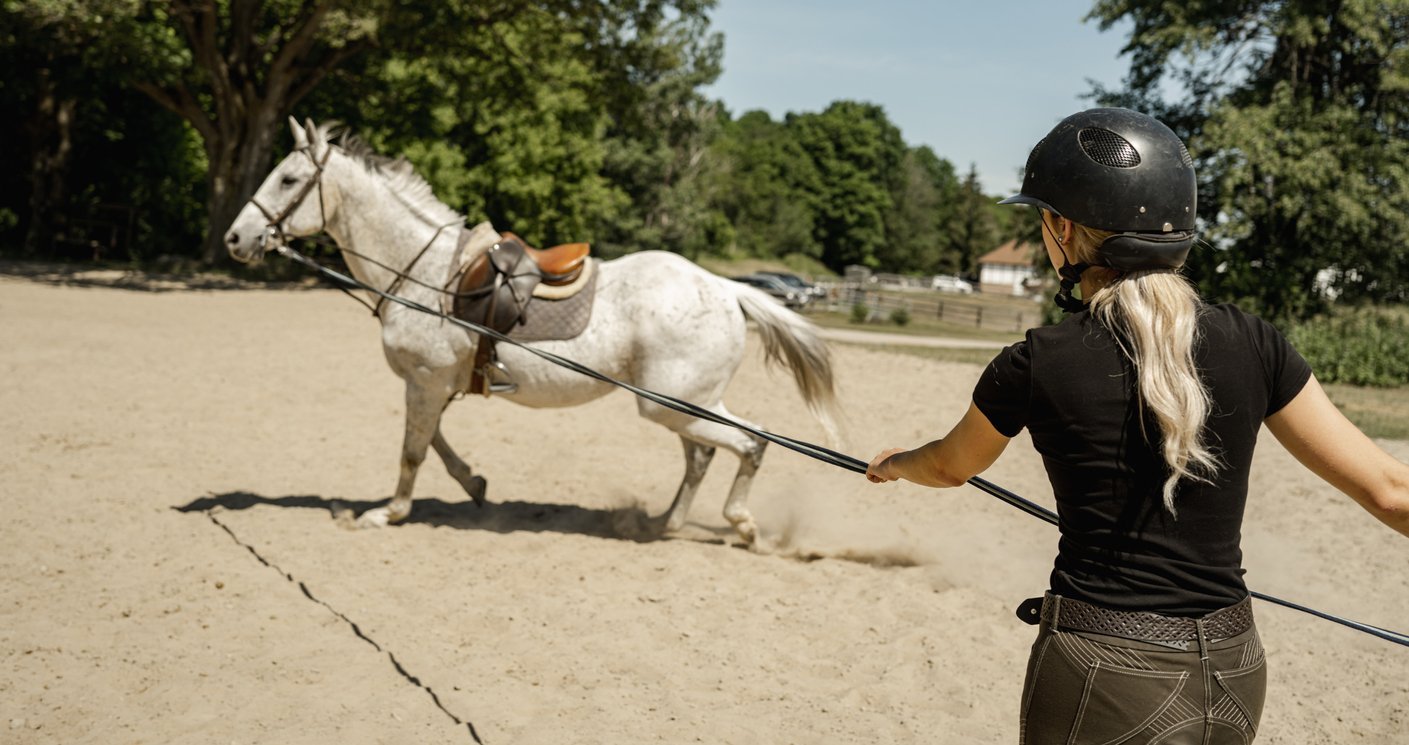
One of the best preventative measures for locking stifle is some simple exercise.
You may not believe it, but by doing locking stifle exercises with your horse, you can make sure they are not only fit but have a better chance of avoiding the condition altogether.
Many horses who struggle with locking stifle are unfit, and their muscle tone is poor. This is believed to be one of the causes of the condition, so that’s why doing locking stifle exercises is so necessary for prevention.
By keeping a healthy weight, and good fitness routine, horses have less weight bearing down on their joints, better muscle tone, and a better chance their bones will sit adequately together in the stifle joint. All of this equates to fewer instances of locking stifle in horses.
In terms of what locking stifle horse exercises you should try with your horse, you’ll want to consult your vet to make a plan together for what some low-impact, rehabilitative training could look like for your horse.
In general, the following tips could help your horse with locking stifle:
- Light stretching of the affected limb by manipulating the horse’s leg in various ways in short (20-30 seconds) intervals
- Hand-led walks in the pasture for warm-ups
- Steady, slow backing (backward walking) either on flat surfaces or up a slight incline for more advanced training
- Riding over low-to the ground poles to encourage leg lifting and muscle development
- Walk them up hills or slopes, and graduate to trotting as they become used to the exercise.
- Employing the help of an equine massage therapist to get your horses’ muscles feeling looser and more supple after exercise
Start slowly and gradually increase these forms of exercise. Always consult your vet before making a plan yourself, as your horse could be facing something more severe than locking stifle, and you want to be sure you’re not horsing around with their health.
Balanced Hoof Trims
Could you imagine walking around with one high heel and one barefoot? It would be uncomfortable and painful on your body, with gait issues and uneven weight distribution.
While that is an extreme comparison, a horse with poorly balanced hooves would feel the same way.
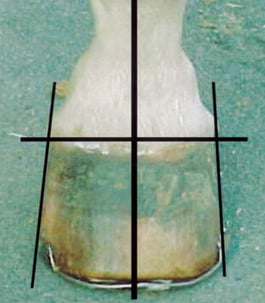
When it comes to shoeing your horse, your go-to pro is a farrier. If you’re an experienced horse owner or just a newbie, you’ll likely understand the importance of balanced shoeing from your farrier.
Balanced hooves mean that the base of the horse’s foot aligns with the center of gravity of their leg. Your farrier should trim your horse’s hooves and shoe them in a way that makes their feet level relative to its legs. That way, the feet and limbs of your horse bear equal weight and allow them to walk with an even gait. This will help prevent horse lameness down the road and allow for their performance longevity.
In some cases, the farrier will trim the inside wall of the hoof and utilize lateral heel extensions. That way, your horse gets a broader stance with more even footing.
The best thing you can do for your horse’s hooves is work closely with your farrier to develop a regular schedule and care routine. Typically, this is a visit from the farrier every 4 to 6 weeks and regular picking and cleaning on your part. Always talk to your farrier and vet if you spot something unusual on your horse.
Supplements for Locking Stifle
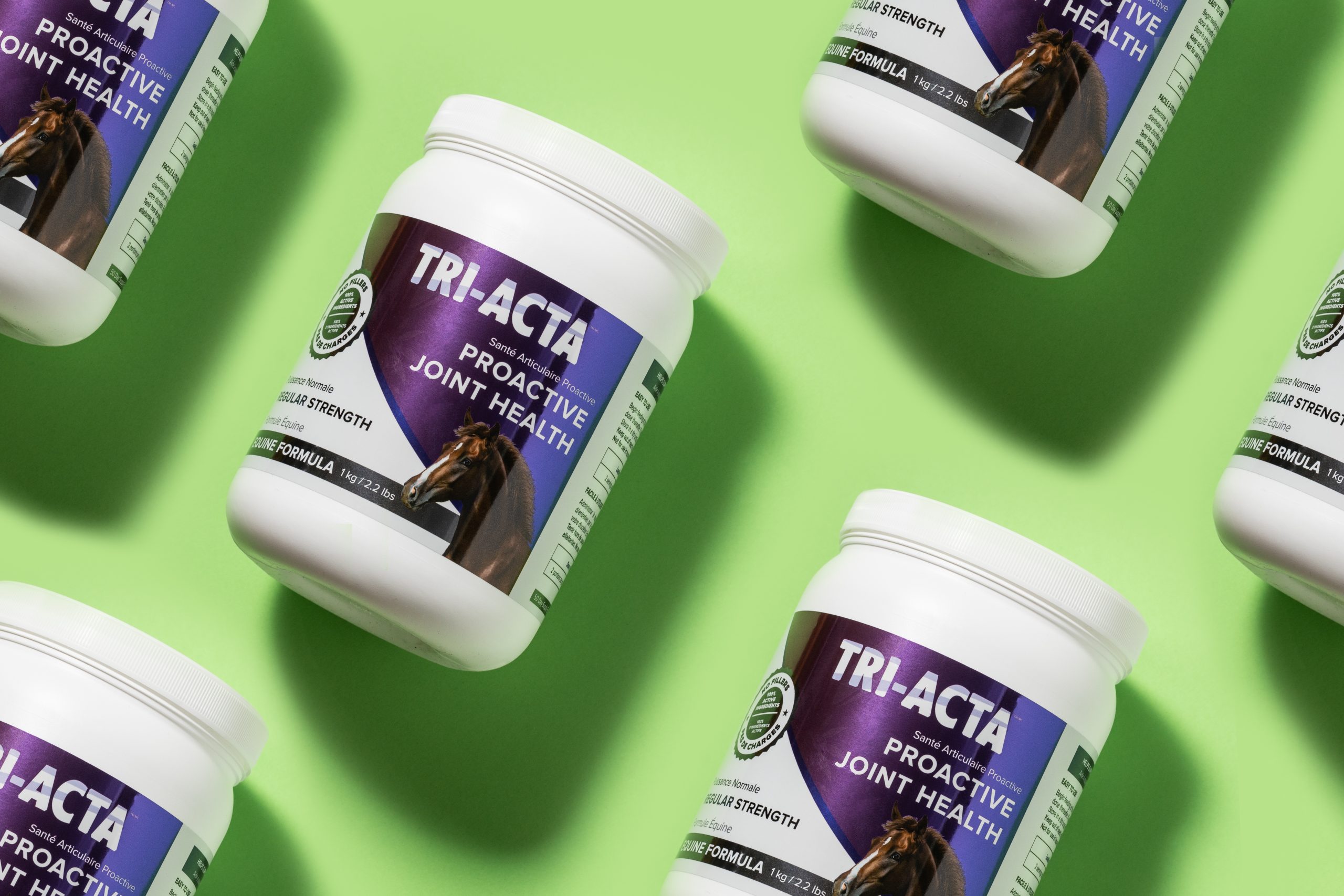
Prevention is vital for almost any kind of health condition in horses.
Specifically, healthy joints are essential for the prevention of locking stifle horse problems. After all, it is often a malformation of the joint or instability that causes joints to lock up.
By adding an equine supplement to your horse’s daily regimen, you can support their joint health and function. It will also boost mobility overall if that is a concern.
Locking stifle horse supplements won’t necessarily guarantee your equine pal will avoid locking stifle altogether, as it can be genetic or breed-related. However, it can give them some comfort and improve the health of their joint tissues and reduce inflammation within the joint.
But what gives locking stifle supplements the power to help your horse?
Horse joint supplements harness the power of these key ingredients to solve joint woes:
- Glucosamine
- MSM
- Chondroitin
- Hyaluronic Acid
Each ingredient has a pivotal role to play in helping the horse’s stifle be fully supported by its ligaments, joint capsule, and tendons.
The role of each key ingredient is outlined in the table below.
|
Locking Stifle Horse Supplement Ingredient |
Benefit |
|
MSM |
Reduces inflammation by inhibiting a protein complex known as NF-kB in your horse’s body’s inflammatory response. |
|
Hyaluronic Acid |
Improves joint lubrication by increasing synovial fluid viscosity. |
|
Chondroitin |
Prevents cartilage breakdown by blocking destructive enzymes from destroying cartilage. |
|
Glucosamine |
Repairs cartilage by helping produce proteoglycans which in turn help produce cartilage. |
TRI-ACTA H.A. for Equine
Our maximum strength formula is perfect for horses that are ageing, experiencing arthritis and stiffness, are in training and competition, or under a heavy workload.
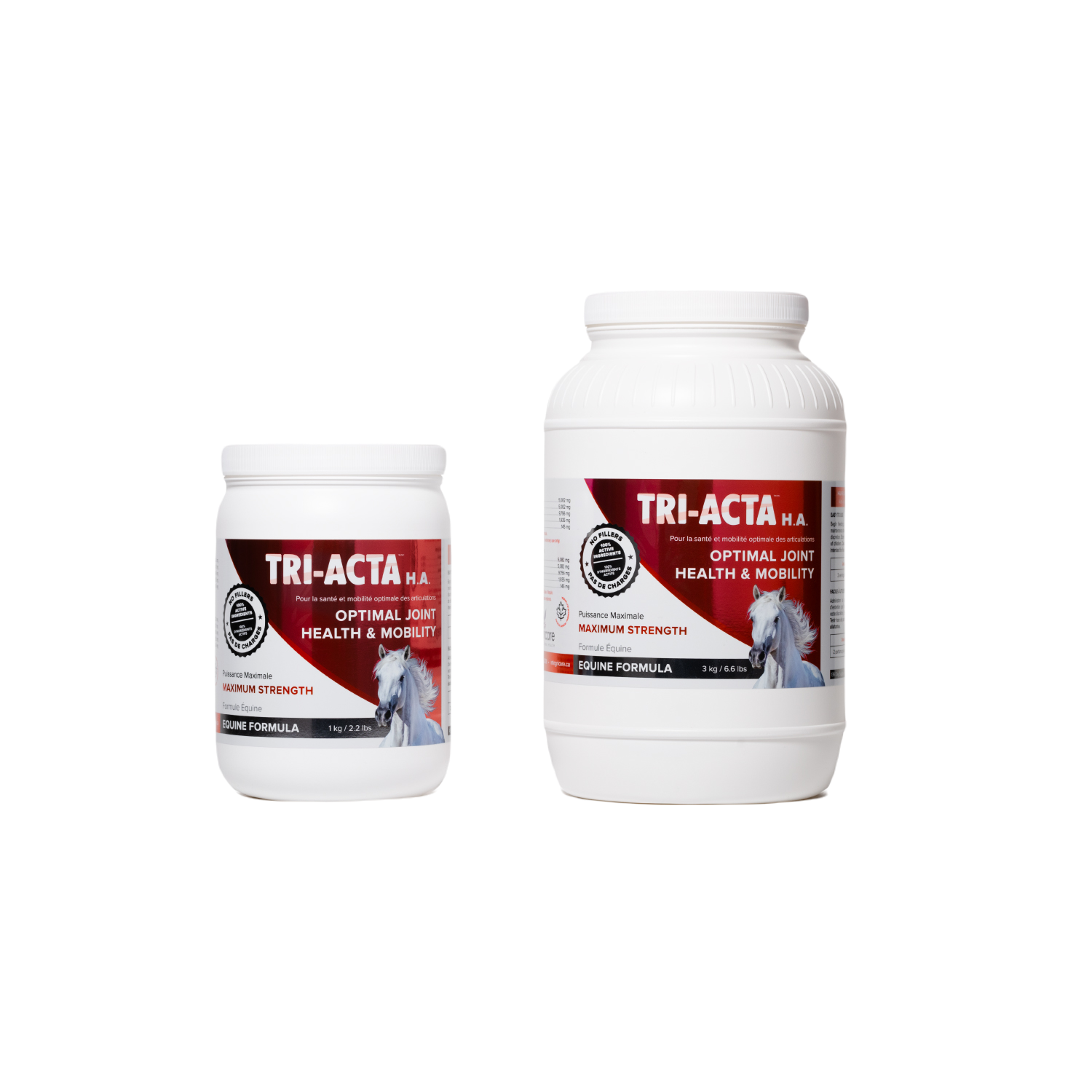
Horse Locking Stifle Treatment Options
If things are going from acute to persistent with your horse’s stifle problems, it’s time to call the vet and consider treatment for locking stifle.
Depending on the severity of the case, several locking stifle treatment options for your horse, and treatments can be used in conjunction with each other to ensure that your horse is as comfortable as possible.
Corrective Shoes
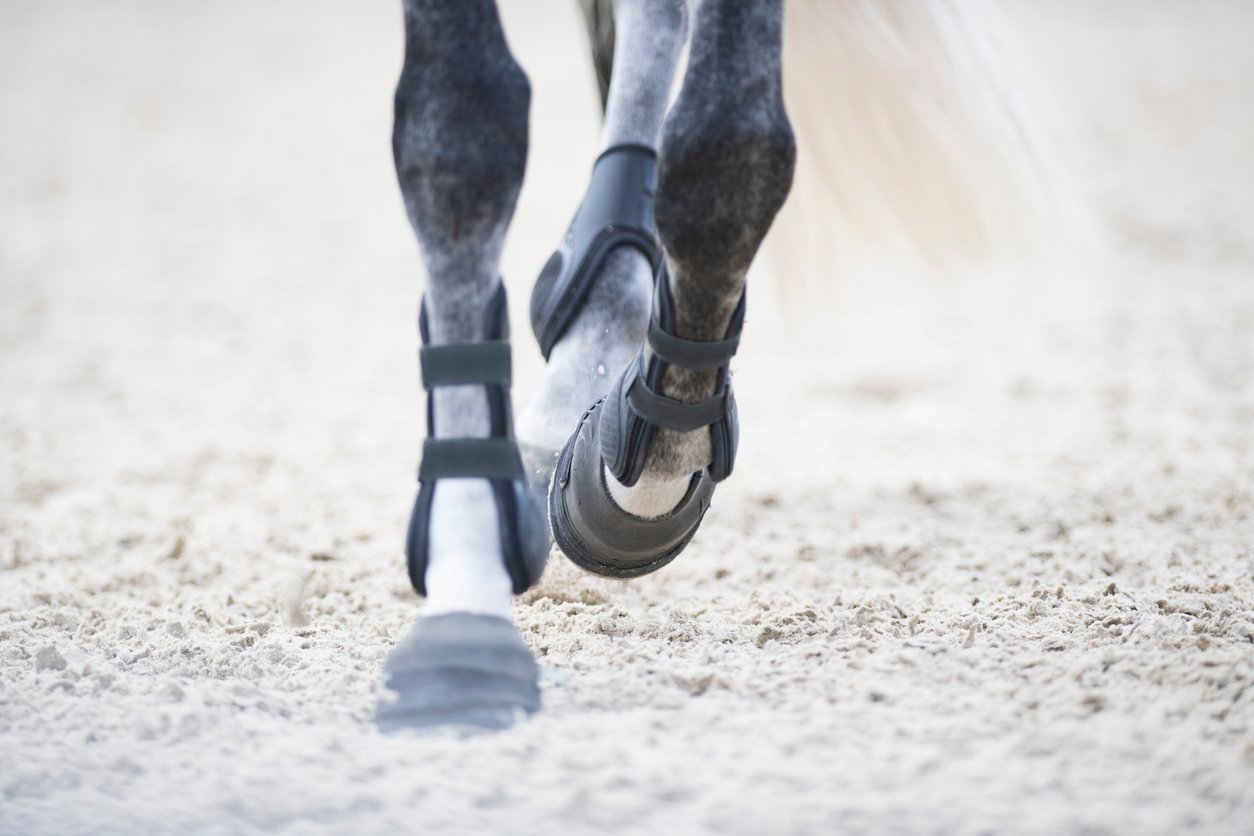
For horses and ponies predisposed to locking stifle due to their conformation, or those who have gained weight and are undergoing a conditioning plan, corrective shoes can be an excellent treatment option for locking stifle.
Typically, corrective shoeing implies the farrier uses a shoe to help compensate for or improve the horse’s conformation and gait. In the case of locking stifle corrective shoeing, the farrier will likely utilize a lateral heel wedge to encourage medial breakover. This wedge will allow your horse to spend a shorter time in “extension” or unlocking the ligament before it becomes too tight or stuck. This works well due to the interrelationship between the horse’s conformation, toe length, and breakover in the hind limbs. In layman’s terms, it means that specific shoeing techniques can help your horse get the last part of its hoof, usually the toes, off the ground before the patella slides up and locks upon them.
Other corrective shoeing techniques considered for locking stifle treatment include:
- Rolling shoeing
- Rockering shoeing
- Full-bar shoeing
Your horse could see a marked improvement by allowing the farrier to control and implement corrective shoeing techniques. One study found that about 50% of horses who received corrective shoeing saw success from their use.
Make sure you consult with both your vet and farrier in order to make a plan that will best suit your horse’s needs.
Injection of Counterirritants
Often prescription joint injections are used to deliver a targeted dose of something like a non-steroidal anti-inflammatory drug.
In the case of treatments for locking stifles, these injections are actually used to create inflammation.
Yep. You read that right — to create inflammation.
Let’s back up for a second. Inflammation and injury create scar tissue at the site of the injury. That makes the damaged and scarred tissue tougher and less elastic.
And while that sounds painful, in the case of treating locking stifle, it can be really helpful. The patella often locks into place due to an unstable joint and a loose ligament getting stuck. By injecting the ligament with an irritant locally, the horse will gain a tougher, less elastic ligament.
The most commonly used counterirritant (or something meant to irritate with the purpose of fixing an underlying problem) injected into the joint as a treatment for locking stifle is iodine mixed with an oil, such as almond oil.
As simple as this locking stifle treatment sounds, never DIY this solution! Only professionals like your vet should perform treatments by injection.
Surgery
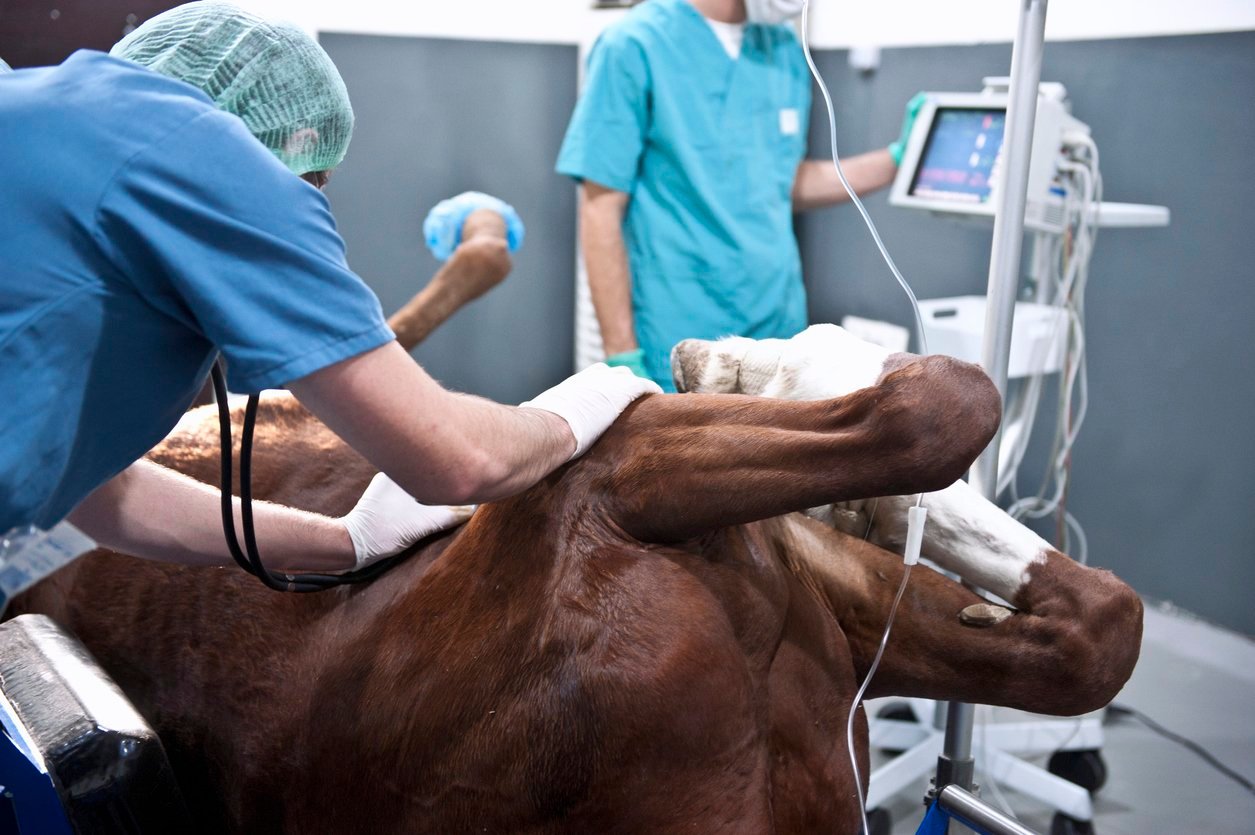
No one wants to see your horse go under the knife if they don’t have to.
But sometimes, surgery is the best locking stifle treatment for your horse.
There are two very common surgeries performed on horses with a locking stifle:
- Medial patellar ligament desmoplasty
- Medial patellar ligament desmotomy
Each of these surgeries serves a different purpose and though neither are ideal to be performed, it can be a very helpful last resort for horses in severe pain with chronic locking stifle.
In the case of medial patella ligament desmoplasty, the veterinarian will cut into the medial patellar ligament with several small incisions throughout the medial patellar ligament.
The success of this procedure is well documented, with one study finding that 71% of horses observed were able to return to normal activities after surgery. Your veterinarian may also perform ultrasound-guided desmoplasty, which utilizes real-time ultrasound imaging during the surgery.
Desmoplasty is much preferred to its more traditional cousin, the medial patellar ligament desmotomy. This surgery technique is not only a mouthful to pronounce, but it can also leave your horse with complications. In desmotomy, the horse’s entire medial patellar ligament is cut, preventing it from catching or locking onto that ridge at the end of the femur.
While it used to be the gold standard for horses with locking stifle, research has shown that there can be problems post-op including:
- Osteoarthritis
- Osteochondral fragmentation of the patella
- Femoropatellar synovitis
- Subchondral lysis
These challenging conditions are essentially all disorders affecting the joints and will make your horse’s quality of life equally as poor, if not worse, than prior to the desmotomy procedure.
Ultimately, your veterinarian will be able to decide what is best for your horse and will be able to guide you through the pre-and post-operative process in whatever way is best for your horse.
Supplements For Locking Stifle
When it comes to locking stifle, your horse needs help with:
- Reducing inflammation
- Pain management
- Mobility
- Joint stability, and structural support
One tool that will assist in checking each one of those items off your list?
Horse supplements for locking stifle.
Whether your horse is recovering from surgery, or you are using a combination of other locking stifle treatments to get your horse feeling neigh pain, supplements for locking stifle can be a helpful addition to any plan.
Ingredients like MSM, glucosamine, chondroitin and hyaluronic acid work together to help with each one of those pain points we just mentioned. Chondroitin prevents cartilage breakdown. Hyaluronic acid works to improve synovial fluid viscosity, while glucosamine helps repair cartilage. MSM works to reduce inflammation caused by irritation in the joint, reducing pain along the way.
And before you say “hay — you just told us localized inflammation helps”, we should make it clear that intentional, targeted inflammation caused by injecting counterirritants is very different to the painful, untargeted inflammation that happens because of locking stifle horse problems. MSM is the key to soothing that discomfort and bringing mobility back to your equine pal.
The thing is, not every supplement is created equally. You want to find a locking stifle supplement that offers you an easy-to-administer formula and a therapeutic dose of each ingredient we listed above.
Enter: Integricare’s lineup of equine joint supplements.
With our extra-strength formula, TRI-ACTA H.A., your horse gets a therapeutic dose of each of the joint health superheroes we mentioned in a small serving size with 100% active ingredients. That means a more concentrated formula and a better cost per serving for you.
Plus, TRI-ACTA offers your horse two forms of glucosamine in its formulas.
But what makes that so beneficial?
By having two forms of glucosamine, your horse will get the unique benefits of both, as outlined in the table below.
| Glucosamine Hydrochloride | Glucosamine Sulfate |
|
|
By offering both forms of glucosamine, as well as a host of other important ingredients, TRI-ACTA H.A. is ideal for horse owners who need treatment for locking stifle.
TRI-ACTA H.A. for Equine
Our maximum strength formula is perfect for horses that are ageing, experiencing arthritis and stiffness, are in training and competition, or under a heavy workload.

Frequently Asked Questions
Would You Buy a Horse With Locking Stifle?
A horse with actively locking stifles may not be safe to ride and therefore is not a good investment to purchase. To detect the problem before purchasing a horse, ride the horse at all gaits, in circles and walk them up and down inclines. If you do like a horse with the condition, find out the cause of the locking stifle, as some issues are easy to manage with the right treatment. Most young horses will outgrow the condition with the right exercise plan, diet, and supplements.
Can a Horse With Locking Stifle Be Ridden?
Depending on the severity of the locking stifle, some horses may not be safe to ride. Horses with mild locking stifle conditions may be ridden as long as the symptoms are monitored. Overuse of a horse with locking stifle or riding a horse with a confirmed stifle injury could result in requiring surgery.
Start Treating Locking Stifle in Horses
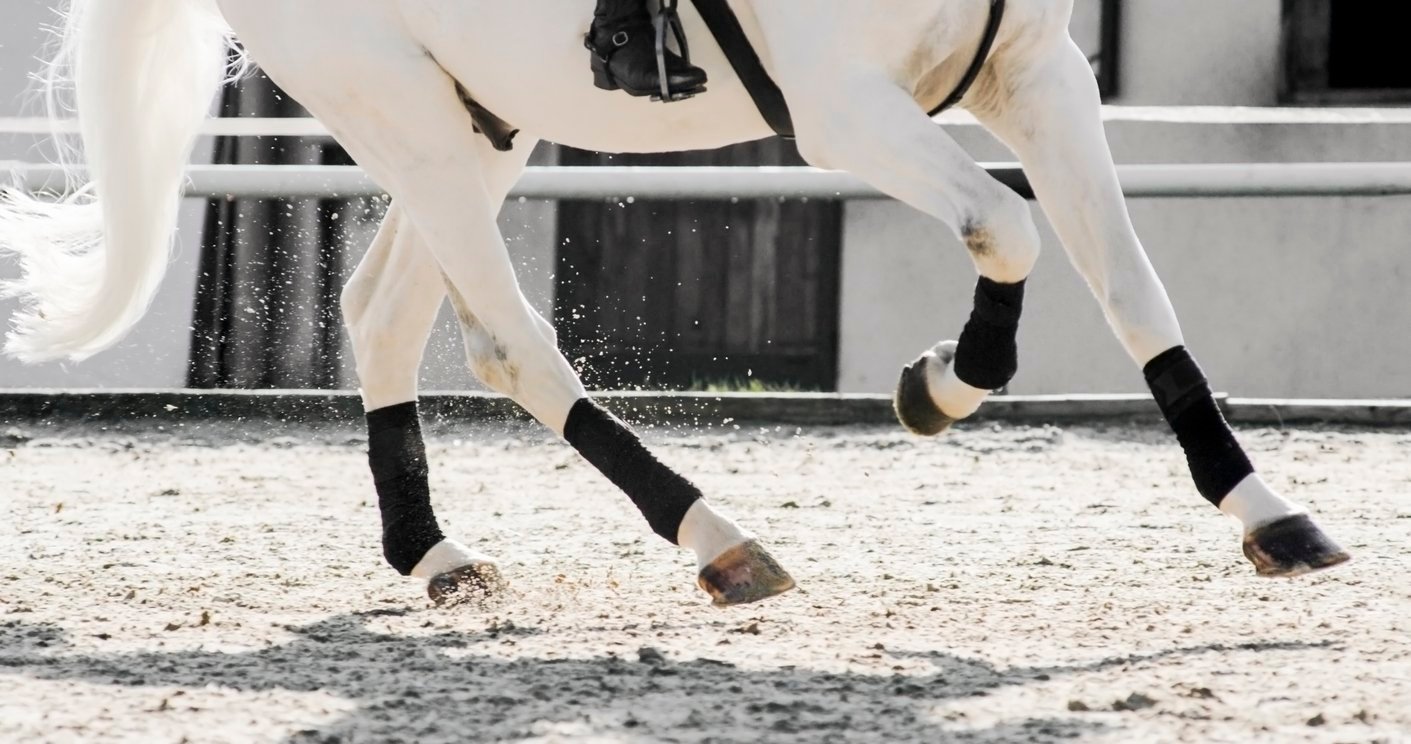
We’ve covered everything from causes to symptoms, as well as prevention and treatment, so you can give your horse the chance to run, jump, and trot for the rest of their days pain-free and without painful locking up of their stifle joint.
And one of the best ways to make sure your horse has the healthiest joints possible is to implement a locking stifle supplement like Integricare’s TRI-ACTA H.A. It offers you a therapeutic dose of key joint health ingredients with a great cost-per-serving.
TRI-ACTA H.A. for Equine
Our maximum strength formula is perfect for horses that are ageing, experiencing arthritis and stiffness, are in training and competition, or under a heavy workload.
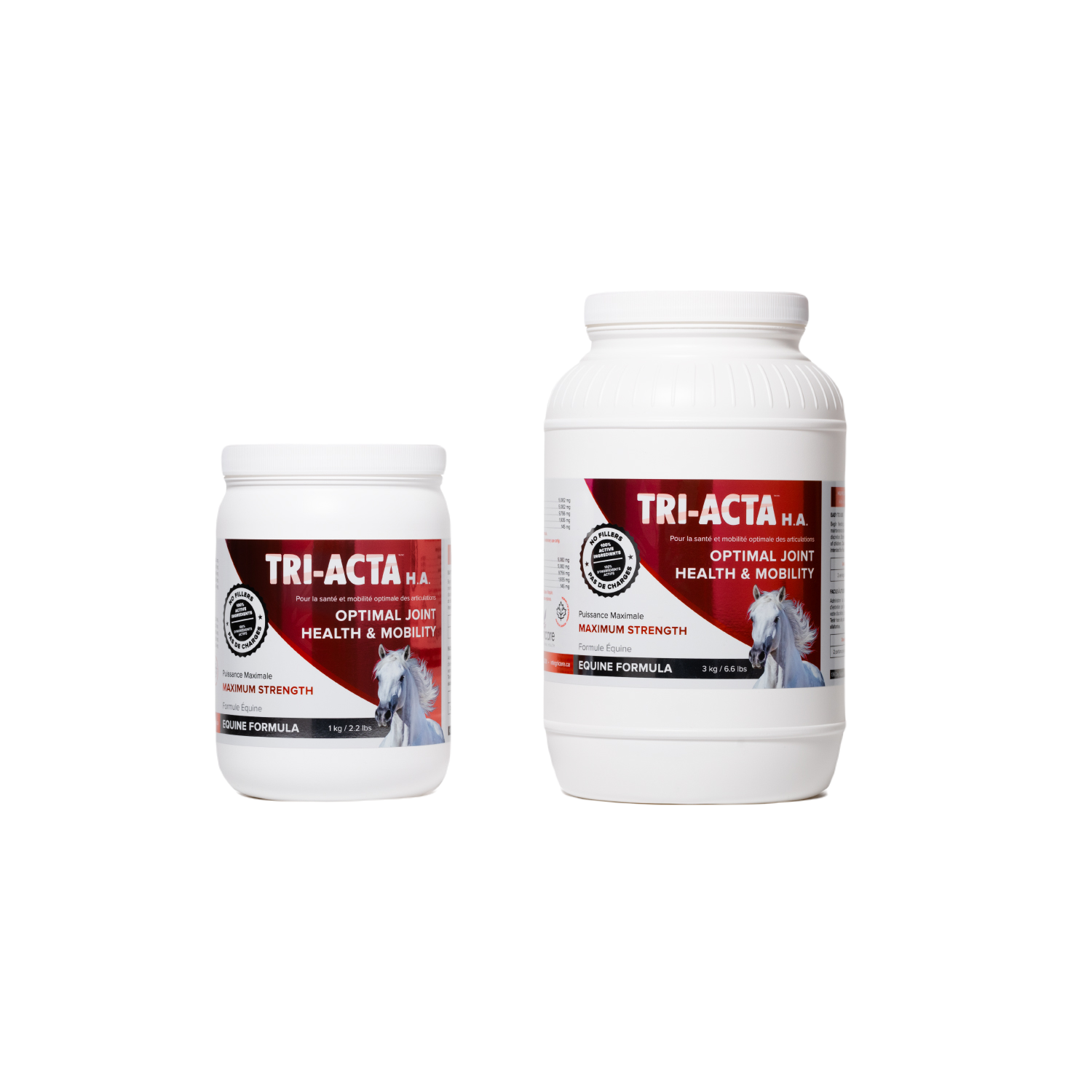
With all of this in mind, you’re ready to saddle up and start preventing and treating locking stifle horse concerns.
Newsletter Signup
Subscribe to our newsletter to receive the latest news and exclusive offers.
.jpg?height=2000&name=Cliick_Integricare-DISPLAY-REVISEDV2%20(1).jpg)
Proactive & Therapeutic Joint Supplements
When given daily, Integricare joint supplements recover bone and joint injuries faster and help prevent mobility injuries from happening in the first place.

